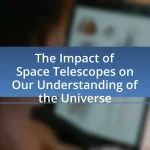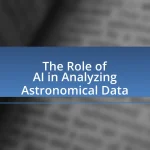The article explores the cultural significance of celestial observations across various societies, highlighting their roles in shaping calendars, navigation, and religious practices. It examines how ancient civilizations, such as the Maya and Egyptians, utilized celestial events to dictate agricultural cycles and societal structures. Additionally, the article discusses the impact of celestial observations on modern cultural identities, community gatherings, and governance, as well as their relevance in contemporary technology and environmental understanding. By analyzing historical and modern interpretations of celestial phenomena, the article underscores the profound connection between astronomy and cultural practices throughout human history.
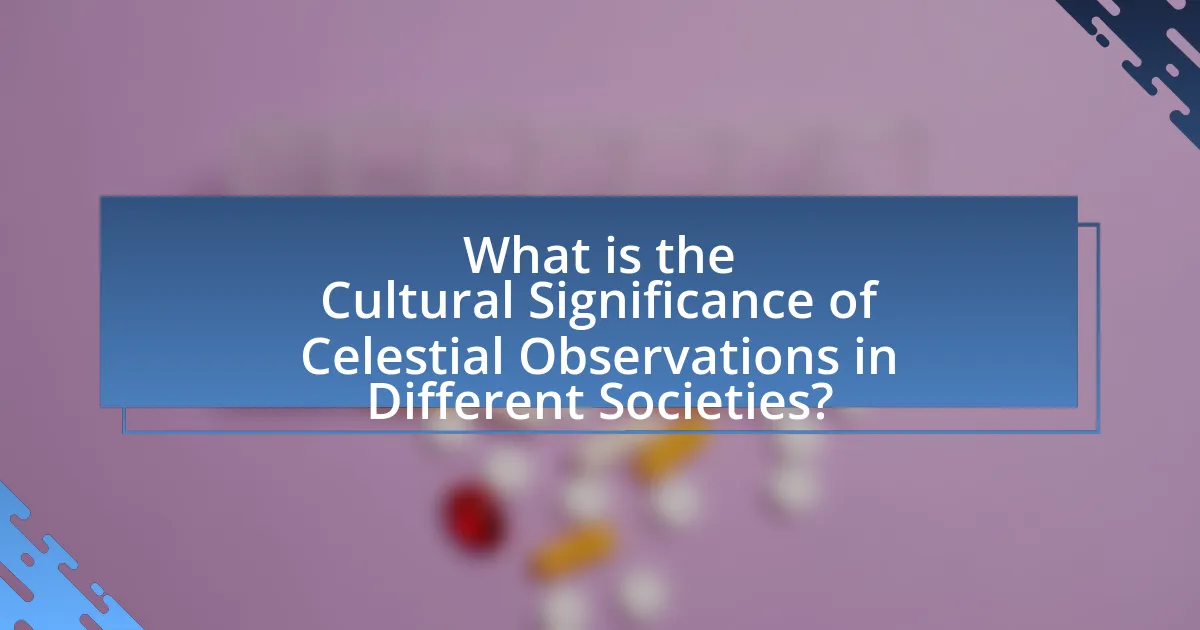
What is the Cultural Significance of Celestial Observations in Different Societies?
Celestial observations hold significant cultural importance across various societies, serving as a foundation for calendars, navigation, and religious practices. For instance, ancient civilizations like the Maya and Egyptians utilized celestial bodies to create intricate calendars that dictated agricultural cycles and religious festivals. The Maya’s Tzolk’in calendar was based on the cycles of the Moon and Venus, influencing their societal structure and rituals. Similarly, the Egyptians aligned their pyramids with the stars, reflecting their beliefs in the afterlife and the divine. In many Indigenous cultures, celestial observations are integral to storytelling and oral traditions, linking the cosmos to cultural identity and heritage. This demonstrates that celestial observations are not merely scientific pursuits but are deeply woven into the fabric of cultural practices and beliefs across different societies.
How have celestial observations influenced cultural practices throughout history?
Celestial observations have significantly influenced cultural practices throughout history by shaping calendars, religious rituals, and navigation methods. For instance, ancient civilizations like the Mayans and Egyptians developed intricate calendars based on celestial events, such as solstices and equinoxes, which dictated agricultural cycles and religious festivals. The Mayan calendar, for example, was closely tied to the movements of celestial bodies, impacting their agricultural practices and societal organization. Additionally, celestial observations guided navigation for seafaring cultures, such as the Polynesians, who used stars to navigate vast ocean distances, influencing trade and exploration. These examples illustrate how celestial phenomena have been integral to the development of cultural practices across various societies.
What role did celestial observations play in ancient civilizations?
Celestial observations were crucial for ancient civilizations as they guided agricultural practices, religious rituals, and navigation. For instance, the Mayans developed a sophisticated calendar system based on celestial movements, which allowed them to predict seasonal changes essential for farming. Similarly, ancient Egyptians aligned their pyramids with the stars, reflecting their belief in the afterlife and the importance of celestial bodies in their culture. Additionally, navigators in ancient maritime societies, such as the Polynesians, relied on the stars for long-distance travel, demonstrating the practical applications of celestial observations in daily life and survival.
How do celestial observations shape modern cultural identities?
Celestial observations shape modern cultural identities by influencing beliefs, traditions, and practices across various societies. For instance, many cultures use celestial events, such as solstices and lunar phases, to mark significant seasonal changes, which in turn informs agricultural practices and festivals. The Mayan civilization, for example, developed a complex calendar system based on celestial movements, which remains integral to their cultural identity today. Additionally, celestial navigation has historically guided exploration and trade, fostering a sense of community and shared heritage among seafaring cultures. This connection to the cosmos continues to inspire art, literature, and spirituality, reinforcing cultural identities in contemporary society.
Why are celestial observations important in various belief systems?
Celestial observations are important in various belief systems because they serve as a means to understand the cosmos and its influence on human life. Many cultures have historically linked celestial events, such as eclipses and solstices, to divine messages or omens, shaping their religious practices and calendars. For instance, ancient civilizations like the Maya and Egyptians used astronomical alignments to guide agricultural cycles and religious ceremonies, demonstrating the integration of celestial phenomena into their spiritual frameworks. This connection between the heavens and earthly events underscores the role of celestial observations in providing a sense of order and meaning within different belief systems.
How do different cultures interpret celestial events?
Different cultures interpret celestial events through unique lenses shaped by their historical, spiritual, and social contexts. For instance, ancient Mesopotamians viewed celestial phenomena as omens from the gods, influencing their agricultural practices and political decisions. In contrast, Indigenous Australian cultures often see celestial events as integral to their Dreamtime stories, linking the cosmos to their ancestral narratives and land. Similarly, in Hinduism, celestial events like eclipses are seen as significant spiritual occurrences, prompting rituals and fasting. These interpretations reflect the diverse ways societies connect celestial phenomena to their beliefs, practices, and worldviews, demonstrating the profound cultural significance of such events across different civilizations.
What significance do celestial bodies hold in religious practices?
Celestial bodies hold significant roles in religious practices as they often symbolize divine presence, influence rituals, and guide calendars. Many cultures, such as the ancient Egyptians, revered the sun and stars, associating them with gods and the afterlife, which shaped their religious beliefs and practices. For instance, the alignment of the pyramids with celestial bodies reflects their importance in rituals and funerary practices. Similarly, in Hinduism, celestial bodies like the moon and planets are integral to astrology, influencing auspicious timings for ceremonies. This connection between celestial observations and religious practices underscores the profound impact of astronomy on spiritual life across various societies.
What are the common themes in celestial observations across cultures?
Common themes in celestial observations across cultures include the use of celestial bodies for navigation, agricultural planning, and religious or spiritual significance. Many societies have historically relied on the positions of stars and planets to guide travel and farming cycles, as seen in ancient Polynesian navigation techniques that utilized the stars for oceanic travel. Additionally, celestial events such as eclipses and solstices often hold religious importance, exemplified by the Mayan calendar, which was intricately linked to astronomical phenomena. These themes demonstrate a universal human connection to the cosmos, reflecting both practical and spiritual dimensions across diverse cultures.
How do myths and legends relate to celestial phenomena?
Myths and legends often serve to explain celestial phenomena by attributing human-like qualities or narratives to celestial bodies and events. For example, many cultures have myths that personify the sun and moon, such as the Inca belief in Inti, the sun god, who was central to their agricultural calendar and rituals. These narratives not only provide a framework for understanding the natural world but also reflect the cultural values and social structures of the societies that created them. Additionally, celestial events like eclipses or meteor showers are frequently woven into myths, often interpreted as omens or messages from the divine, which further illustrates the deep connection between human storytelling and astronomical occurrences.
What similarities exist in agricultural practices linked to celestial observations?
Agricultural practices linked to celestial observations share the similarity of timing planting and harvesting according to lunar phases and seasonal changes dictated by celestial events. Many cultures, such as the ancient Egyptians and Mayans, aligned their agricultural calendars with the cycles of the moon and the positions of stars, which helped optimize crop yields. For instance, the lunar calendar was crucial for determining the best times for sowing seeds and harvesting, as it was believed that certain phases of the moon influenced plant growth. This practice is supported by historical records indicating that societies relied on celestial patterns to enhance agricultural productivity, demonstrating a universal connection between astronomy and farming across various cultures.
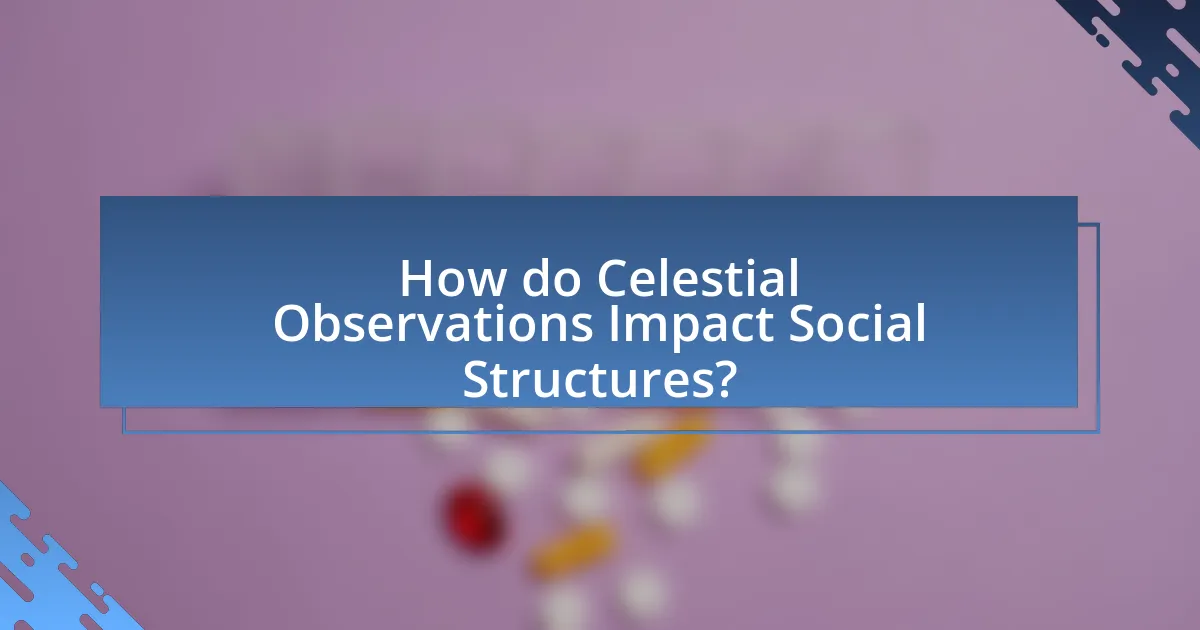
How do Celestial Observations Impact Social Structures?
Celestial observations significantly impact social structures by influencing agricultural practices, religious beliefs, and navigation systems. For instance, ancient civilizations like the Maya and Egyptians relied on celestial events to create calendars that dictated agricultural cycles, which in turn shaped their societal organization and labor distribution. The alignment of structures such as Stonehenge with celestial bodies illustrates how these observations were integral to community rituals and governance. Furthermore, celestial navigation was crucial for maritime societies, enabling trade and cultural exchange, which fostered complex social hierarchies and interactions. Thus, celestial observations have historically been foundational in shaping the social frameworks of various cultures.
What role do celestial observations play in community gatherings?
Celestial observations serve as a focal point for community gatherings by fostering social cohesion and shared cultural identity. These observations often align with significant events, such as harvest festivals or religious ceremonies, where communities come together to celebrate and reflect on their connection to the cosmos. For example, many indigenous cultures use celestial events, like solstices and lunar phases, to mark seasonal changes, guiding agricultural practices and communal activities. This practice not only strengthens community bonds but also reinforces cultural traditions and knowledge passed down through generations.
How do celestial events influence festivals and celebrations?
Celestial events significantly influence festivals and celebrations by serving as markers for time, agricultural cycles, and cultural rituals. For instance, the timing of the harvest moon is celebrated in various cultures, such as the Mid-Autumn Festival in China, which aligns with the full moon and signifies the harvest season. Additionally, solar and lunar eclipses have historically prompted celebrations or rituals, as seen in the ancient Mayan civilization, where eclipses were interpreted as significant omens. These events not only dictate the timing of festivities but also shape the themes and practices associated with them, reinforcing community bonds and cultural identity.
What impact do celestial observations have on leadership and governance?
Celestial observations significantly influence leadership and governance by providing a framework for decision-making and establishing authority. Historically, leaders have utilized celestial events, such as eclipses and planetary alignments, to legitimize their rule and make strategic decisions. For instance, ancient civilizations like the Maya and Egyptians relied on astronomical knowledge to create calendars that dictated agricultural practices and religious ceremonies, thereby reinforcing the power of their leaders. Additionally, celestial phenomena have been interpreted as omens, guiding rulers in times of crisis, as seen in the Roman Empire where comets were viewed as signs from the gods, impacting political actions. This connection between celestial observations and governance underscores the role of astronomy in shaping societal structures and leadership legitimacy throughout history.
How do celestial observations affect navigation and exploration?
Celestial observations significantly enhance navigation and exploration by providing reliable reference points for determining location and direction. Historically, navigators have utilized celestial bodies, such as the sun, moon, and stars, to establish their position on Earth. For instance, ancient mariners relied on the North Star, Polaris, to find true north, which was crucial for charting courses across oceans. The development of tools like the astrolabe and sextant further exemplifies how celestial observations have been instrumental in improving navigational accuracy, allowing explorers to traverse vast distances with greater confidence. These practices laid the foundation for global exploration, enabling civilizations to expand their horizons and engage in trade and cultural exchange.
What techniques have been developed for celestial navigation?
Celestial navigation techniques include the use of sextants, chronometers, and celestial bodies for determining position at sea. The sextant allows navigators to measure the angle between a celestial body and the horizon, while chronometers provide accurate timekeeping essential for calculating longitude. Additionally, navigators utilize the positions of stars, the sun, and the moon, often referencing established star charts and tables, to ascertain their geographic location. Historical evidence shows that ancient civilizations, such as the Polynesians and the Greeks, effectively employed these techniques, demonstrating their cultural significance in navigation and exploration.
How have celestial observations contributed to trade and commerce?
Celestial observations have significantly contributed to trade and commerce by enabling navigation and timekeeping. Ancient mariners relied on the positions of stars and celestial bodies to chart their courses across oceans, facilitating long-distance trade routes. For instance, the Polynesians used the stars for navigation, allowing them to travel vast distances in the Pacific Ocean, which enhanced their trade networks. Additionally, celestial observations helped establish calendars that regulated agricultural cycles and market activities, as seen in ancient Mesopotamia where lunar calendars dictated planting and harvesting times, thus influencing trade in agricultural goods. These practices underscore the integral role of celestial observations in shaping economic interactions and trade efficiency throughout history.
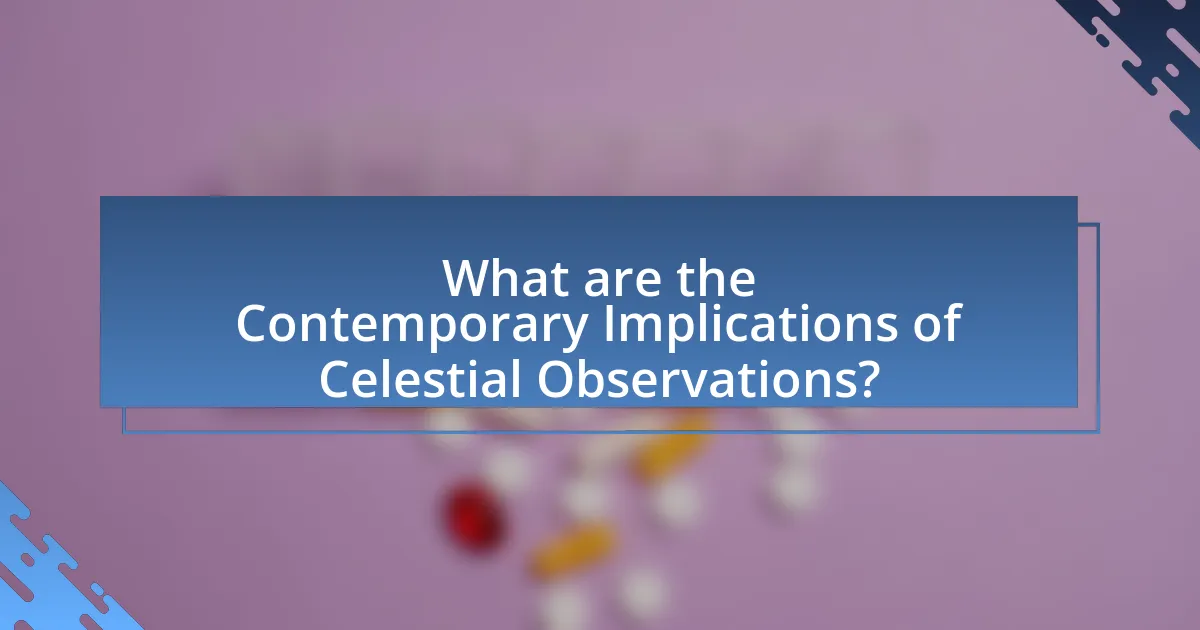
What are the Contemporary Implications of Celestial Observations?
Contemporary implications of celestial observations include advancements in technology, navigation, and climate science. These observations have led to the development of satellite systems that enhance global positioning and communication, as evidenced by the widespread use of GPS technology, which relies on data from celestial bodies. Additionally, celestial observations contribute to our understanding of climate change through the monitoring of atmospheric conditions and celestial phenomena, such as solar activity, which can impact Earth’s climate. Furthermore, the cultural significance of celestial observations persists, influencing art, literature, and religious practices across various societies, thereby shaping contemporary cultural identities.
How do modern technologies enhance our understanding of celestial observations?
Modern technologies enhance our understanding of celestial observations by providing advanced tools and methods for data collection and analysis. For instance, telescopes equipped with adaptive optics can correct atmospheric distortions, allowing astronomers to capture clearer images of distant celestial bodies. Additionally, space-based observatories like the Hubble Space Telescope eliminate atmospheric interference altogether, enabling observations across various wavelengths, including ultraviolet and infrared. These technologies have led to significant discoveries, such as the identification of exoplanets and the measurement of cosmic background radiation, which supports the Big Bang theory. The integration of artificial intelligence in data analysis further accelerates the processing of vast amounts of astronomical data, revealing patterns and insights that were previously unattainable.
What tools are used for celestial observations today?
Telescopes, satellites, and spectrometers are the primary tools used for celestial observations today. Telescopes, including optical and radio varieties, allow astronomers to observe distant celestial bodies and phenomena. Satellites, such as the Hubble Space Telescope, provide high-resolution images and data from space, free from atmospheric interference. Spectrometers analyze the light from stars and galaxies to determine their composition, temperature, and motion. These tools have revolutionized our understanding of the universe, enabling discoveries such as exoplanets and the expansion of the universe.
How has the internet changed the way we share celestial knowledge?
The internet has revolutionized the sharing of celestial knowledge by enabling instantaneous access to vast amounts of information and facilitating global collaboration among astronomers and enthusiasts. Online platforms, such as social media, forums, and educational websites, allow individuals to share observations, research findings, and educational resources in real-time, breaking geographical barriers. For instance, the International Astronomical Union’s use of online databases and collaborative tools has led to increased participation in citizen science projects, allowing amateur astronomers to contribute to significant discoveries. This democratization of knowledge enhances public engagement and fosters a collective understanding of celestial phenomena across diverse cultures.
What lessons can we learn from historical celestial observations for today’s society?
Historical celestial observations teach today’s society the importance of scientific inquiry and cultural understanding. For instance, ancient civilizations like the Babylonians and Mayans meticulously tracked celestial bodies, leading to advancements in astronomy and calendar systems. These observations not only enhanced agricultural practices through better timing of planting and harvesting but also fostered a sense of community and shared knowledge. The precision of their astronomical calculations, such as the Mayan calendar’s accuracy, demonstrates the value of empirical evidence and systematic observation, which are foundational to modern science. Additionally, these historical practices highlight the need for cultural respect and integration of diverse astronomical traditions, as seen in the blending of indigenous knowledge with contemporary science. This understanding can guide current efforts in education and environmental stewardship, emphasizing collaboration and respect for various cultural perspectives in addressing global challenges.
How can we apply ancient wisdom in modern astronomical practices?
Ancient wisdom can be applied in modern astronomical practices by integrating traditional celestial navigation techniques and cultural interpretations of celestial events into contemporary astronomy. For instance, Polynesian navigators utilized the stars for oceanic navigation, demonstrating a profound understanding of celestial patterns that can enhance modern navigation methods. Additionally, ancient cultures often associated celestial events with agricultural cycles, which can inform current practices in sustainable farming by aligning planting schedules with lunar phases. This integration of historical knowledge not only enriches modern astronomical understanding but also fosters a deeper appreciation for the cultural significance of celestial observations across different societies.
What best practices can be adopted from various cultures regarding celestial observations?
Best practices for celestial observations that can be adopted from various cultures include the use of storytelling to convey astronomical knowledge, as seen in Indigenous Australian cultures, where the stars are integrated into Dreamtime stories that teach navigation and seasonal changes. Additionally, the practice of meticulous record-keeping, exemplified by ancient Chinese astronomers who documented celestial events for over two millennia, can enhance the accuracy of observations. Furthermore, the communal observation practices of the Mayans, who gathered to witness celestial events and celebrate them through rituals, emphasize the importance of community engagement in astronomy. These practices not only enrich the understanding of celestial phenomena but also foster a deeper cultural connection to the cosmos.

